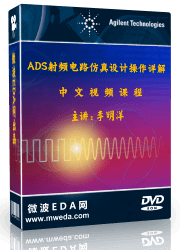- 易迪拓培训,专注于微波、射频、天线设计工程师的培养
Problem with EM Mesh frequency and Mesh Density
This is my circuit :
schematic.png(using CPWG component in TLines-Waveguide)
layout_all.png
layout.png
cosimulation.png
I want to see S11 on the smith chart.
But I don't know exactly how to set the mesh frequency and mesh density at the em setup.
Someone tells me the mesh frequency should be 3 times as much as the operating frequency, and the mesh density can be set to be 20 cells/wavelength.
Here is my em setup:
Mesh setup.png
My operating frequency is at 2.4GHz ,single sweep, so I set the mesh frequency=2.4*3=7.2 GHz, and the mesh density=20.
But when I change the mesh density to be 40, the result on the smith chart is different from the result of which the mesh frequency is 20.
Here is the result, where the green point is the result of schematic, the red point is the result of cosimulation at mesh frequency=40, and the blue point is the one at mesh frequency =20.
result.png
I don't know which is the correct result and setting.
Thanks for replying.
附图/附件

schematic.png

layout_all.png

Layout.png

cosimulation.png

Mesh setup.png

result.png
> But I don't know exactly how to set the mesh frequency and mesh density at the em setup.
> Someone tells me the mesh frequency should be 3 times as much as the operating frequency, and the mesh density can be set to be 20 cells/wavelength.
In other solvers that use FEM 3D simulation, the meshing frequency is used to adaptively refine the mesh, based on simulation results at this frequency.
In Method of Moment, it is much simpler than that: the mesh frequency and the dielectric materials are evaluated, to calculate the wavelength in the dielectric. Then, maximum size of a mesh element is limited to (wavelength in dielectric) / (cells per wavelength). So it is really the same if you use 3*fmax at 20 cells/lambda, or use fmax at 60 cells/lambda.
The importance of mesh density depends on the amount of layout details that force the mesh algorithm to use a denser mesh. If you have a simple layout, the resulting mesh might have many large cells that reach the "cells per wavelength" limit. In a complex, electrically small layout the effective mesh size is determined by the amount of layout detail.
In general, results with higher mesh density are more accurate, because currents on the conductors have more degrees of freedom to flow in the physically correct way when the moment matrix is solved. The only exception would be extreme mesh density or exterem mesh shape where numerical issue might come up.
In your case, we would expect a rather fine mesh density near the line, caused by the via fences. The large areas outside shouldn't have much signal anyway. However, the "Mesh reduction" setting in emSetup > Options > Mesh might have an effect as well. Can you show a screenshot of the mesh view for both cases that you compare?
Thank you for detailed replying.
This is my mesh picture:
For 20 cells/wavelength,
20 cell.png
and 40 cells/wavelength,
40 cell.png
Because my layout has finite ground, there are two types of meshes, which contain pink one(cond 1) and yellow one(cond2)
substrate.png
Is my substrate accurate for finite ground simulation??
Thanks.
jeff0283 on Dec 9, 2015 9:56 AM
附图/附件

20 cell.png

substrate.png

40 cell.png
As far as I can see from the pictures, mesh cells are poorly aligned between the signal conductor and the ground below. That affects capacitance. I would set "Thin layer overlap extraction" in the mesh settings to "Aggressive" to fix that.
Then, maximum size of a mesh element is limited to (wavelength in dielectric) / (cells per wavelength). So it is really the same if you use 3*fmax at 20 cells/lambda, or use fmax at 60 cells/lambda.
>
> The importance of mesh density depends on the amount of layout details that force the mesh algorithm to use a denser mesh. If you have a simple layout, the resulting mesh might have many large cells that reach the "cells per wavelength" limit. In a complex, electrically small layout the effective mesh size is determined by the amount of layout detail.
>
> In general, results with higher mesh density are more accurate, because currents on the conductors have more degrees of freedom to flow in the physically correct way when the moment matrix is solved. The only exception would be extreme mesh density or exterem mesh shape where numerical issue might come up.
In my case, I use 3*fmax at both 20 and 40 cells/lambda, but the results on the smith chart are different.
So I assume the 40 cells/lambda case is more accurate than 20 cells/lambda.
But I can use 3*fmax at 60 cells,80 cells.../lambda and higher mesh density, how can I know how much mesh density is enough for my layout??
> In my case, I use 3*fmax at both 20 and 40 cells/lambda, but the results on the smith chart are different.
> So I assume the 40 cells/lambda case is more accurate than 20 cells/lambda.
Yes, that's what we usually see: denser mesh is better.
> But I can use 3*fmax at 60 cells,80 cells.../lambda and higher mesh density, how can I know how much mesh density is enough for my layout??
As I tried to explain, it is not that simple. Having a "good" mesh with accurate enough results depends on multiple influences, and cells/wavelength is only one of them.
There is some other meshing detail (mesh aligment between layers) that seems to change your results. That mesh alignment is indirectly changed by higher cells/wave count, but the best method is to fix the mesh alignment with the appropriate setting.
I have removed the finite ground ,so the substrate has been with infinite ground, and done the em simulation with 3*fmax for mesh frequency, 20 and 40 cells/wavelength for mesh density.
infinite substrate.png
But the result on the smith chart is quite close together.
So I guess it is the finite substrate that causes the different results for different mesh density(20 and 40 cells/wavelength).
But I don't know if my finite ground substrate is correct...
Is this right?
finite ground.png
Or should I add an infinite ground plane below the bottom metal?
finite ground with infinite.png
Or should I add hole to contact bottom metal and infinite ground plane?
finite ground with infinite and hole.png
附图/附件

finite ground.png

infinite substrate.png

finite ground with infinite and hole.png

finite ground with infinite.png
> So I guess it is the finite substrate that causes the different results for different mesh density(20 and 40 cells/wavelength).
Yes, this confirms what I wrote above: the difference are from insufficient aligment of the mesh cells between top and bottom conductor. There is a Moment mesh setting to fix that, as described above.
But for your case, with no relevant holes, you can use simply use infinite ground.
> But for your case, with no relevant holes, you can use simply use infinite ground.
Do you mean my layout has few holes? Why?
> Do you mean my layout has few holes? Why?
Don't worry, your layout is perfectly suited for infinite ground simulation.
Hi Volker:
Do you think if this layout is suited for infinite ground simulation?
PA.png
ps. The yellow is the finite ground plane
jeff0283 on Dec 27, 2015 8:39 AM
附图/附件

PA.png
> Do you think if this layout is suited for infinite ground simulation?
Yes, absolutely!
> So I guess it is the finite substrate that causes the different results for different mesh density(20 and 40 cells/wavelength).
>
> Yes, this confirms what I wrote above: the difference are from insufficient aligment of the mesh cells between top and bottom conductor. There is a Moment mesh setting to fix that, as described above.
>
> But for your case, with no relevant holes, you can use simply use infinite ground.
Hi volker,
I am doing the em co-simulation to see the impedance on smith chart at freq=2.34GHz.
234.png
I use the same mesh density=20 cells/wavelength but different mesh frequencies,which are 3*2.34=7.02GHz(red point) and 3*3*2.34=21.06GHz(pink point).
result.png
In general, the result will converge and be more accurate when the mesh frequency gets higher, isn't it?
I think 3*fc is enough for mesh frequency, so I think the result of mesh frequency=3*3*fmax should be quite similar to the one of mesh frequency 3*fc, but the results are different.
Because I use infinite substrate, I think there is no alignment problem.
infinite substrate.png
Do you know what the problem is??
附图/附件

result.png

234.png

infinite substrate.png
申明:网友回复良莠不齐,仅供参考。如需专业帮助,请学习易迪拓培训专家讲授的ADS视频培训课程。
上一篇:Momentum port setup at transistor input above 100 GHz
下一篇:ADS2015 GDS export flatten and merge option removed?
ADS娑擃厽鏋冪憴鍡涱暥閸╃顔勯弫娆戔柤 | More...
 国内最全面、最专业的Agilent ADS培训课程,可以帮助您从零开始,全面系统学习ADS设计应用【More..】
国内最全面、最专业的Agilent ADS培训课程,可以帮助您从零开始,全面系统学习ADS设计应用【More..】
- Agilent ADS教学培训课程套装
- 两周学会ADS2011、ADS2013视频教程
- ADS2012、ADS2013射频电路设计详解
- ADS高低阻抗线微带滤波器设计培训教程
- ADS混频器仿真分析实例视频培训课程
- ADS Momentum电磁仿真设计视频课程
- ADS射频电路与通信系统设计高级培训
- ADS Layout和电磁仿真设计培训视频
- ADS Workspace and Simulators Training Course
- ADS Circuit Simulation Training Course
- ADS Layout and EM Simulation Training Course
- Agilent ADS 内部原版培训教材合集








